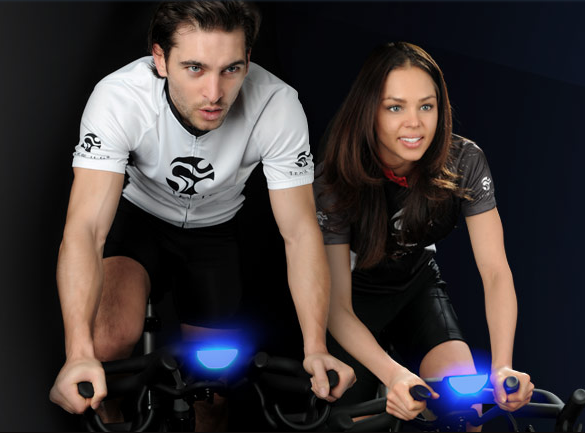I finally got to ride one of the Indoor Cycling Group IC7 bikes at IDEA last week and it was every bit as wonderful as I expected. I sat and pedaled (easily for the most part) on the bike in the booth for about 45 minutes, while Chris Plourde explained the bike and the program, and Graham Stoney, one of the chief brains behind the engineering, explained the power meter to me.
The bike, manufactured by Matrix, is the IC7 (the IC5 doesn’t have the console). The company, the Indoor Cycling Group (ICG), is popular in Europe, and has been a major player over there for two decades. ICG has recently been pushing into the North American market, especially after the recent launch of the IC7.
What sets the IC7 apart from any other program is the Coach by Color concept. Power zones are set using various assessments (including a 20-minute field test). ICG labels FTP (functional threshold power) as FTW (functional threshold wattage). Riders enter their FTW, and the meter gives them their zones. The meter then lights up with the color of the zone they are in. White for very easy, blue for light, green for moderate, yellow for hard, red for maximum. Can you imagine how much easier this would be to do a field test, or any assessment for that matter?
Train by Color concept is truly brilliant, and provides a way for riders to know at a glance whether they are putting out the desired effort. The beauty of this coaching by color is that you can have a beginner non-cyclists riding next to a metrics-loving cycling geek and they will all “get it” far more easily than with most methods of teaching with power. The following, from the TeamICG website, explains why the color-coded system is so valuable:
A very small percentage of consumers have any understanding of Power and power-based training. To the vast majority it’s “another number” that creates a layer of complexity to their otherwise well rehearsed, and loved workouts. To make Power powerful, we first need to make it simple by using color to remove the technical and practical barriers associated with working with numbers. Not only is switching between a user’s personalized blue and red zone, or holding the yellow zone fun, users quickly and intuitively learn what the “numbers” mean in terms of effort. Through Coach By Color® we will ensure power-based training is inclusive and widely adopted, so cycling’s ultimate training tool can help us in wellness, fitness, and athletic performance.
The resistance dial of the IC7 is another excellent advancement in the industry. On most bikes, you have to turn the resistance knob numerous times to get any resistance, and to return to a previous resistance for an interval is imprecise and difficult. The new resistance knob turns through a 300-degree range, numbered from 0 to 100. One turn, one small click, and you get immediate increase.
This means that when doing intervals, you can immediately return to the same (or higher) resistance that you achieved in the previous interval, without having to continually fine tune the dial. This is especially helpful for Tabata intervals.
One thing I loved about this bike is that even at “zero” there’s still some resistance, so you won’t have the freewheeling you’ll find with so many bikes.
Master Trainer Chris Plourde and I were playing around on the bike and filmed the following short video. Chris and I were both a part of the Spinning® Master Instructor team years ago.
ICG Master Trainer Chris Plourde takes Jennifer Sage through the power
zones on the IC7 at the IDEAFIT expo, July 2015


I tried these and found that they are better for resistance (i.e, strength) training than aerobic training, which is why I take cycling class. My heart rate was nowhere near where it should have been for aerobic training, but my legs were sore afterwards. I will therefore be switching back to treadmill and rower for an aerobic workout, and stick to weights for real strength training, rather than the kind of half-baked muscle toning these cycles seem to promote.
Our Y just got these bikes and we love them! I was already coaching with RPM and PPE cues, and this system really helps the clients understand how they work in concert with each other. My only negative on this bike is that it isn’t made for the very short riders. I can’t say enough about how much our coaching staff loves riding and coaching on these bikes!
I’m a indoor cycling instructor who uses Keiser and Star Trac bikes. I like both of those way better than this bike, which I tried last week. Here’s why: the frame is SOOOOOOO wide and high, my legs rub against it with every revolution.
Interesting Maggie, I wonder if it’s an older version? Where was it that you rode these bikes? I sat there pedaling for almost an hour, chatting with Chris and Graham about the bike, and I never felt that at all. I’m pretty sensitive to things like that.
On an earlier model of the Spinner NXT, that we rode at WSSC, my joints were in pain because the Q angle of that bike was wider than most, and it really affected my pedaling. The Q angle is related to the width of the bottom bracket—the wider it is, the further apart the pedals (and your legs) are.